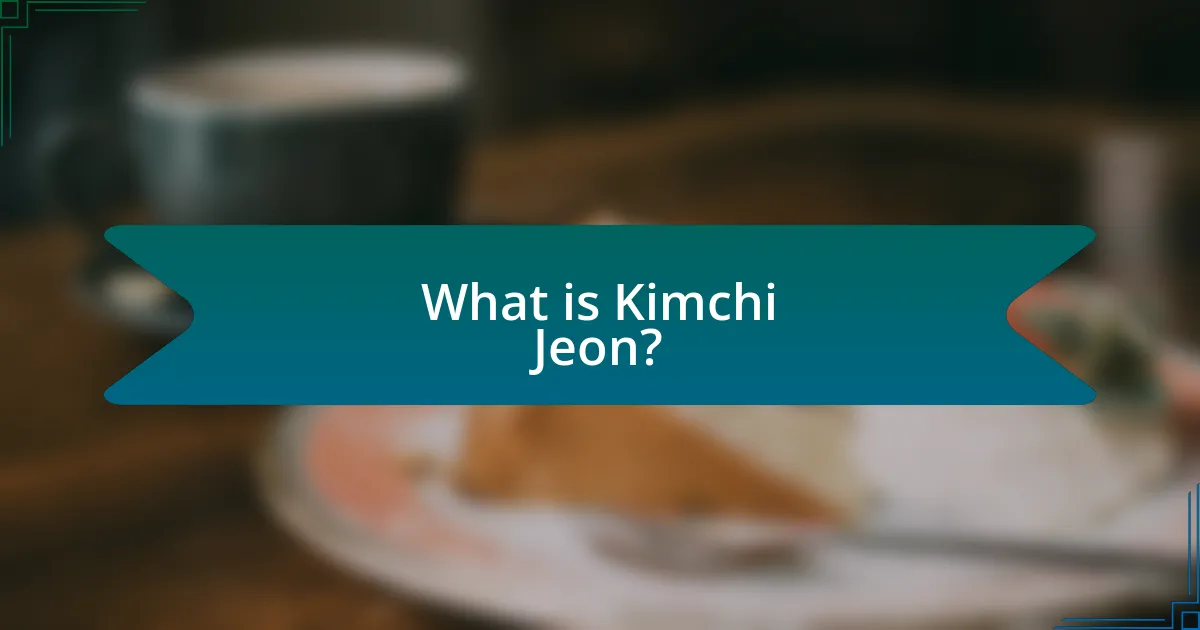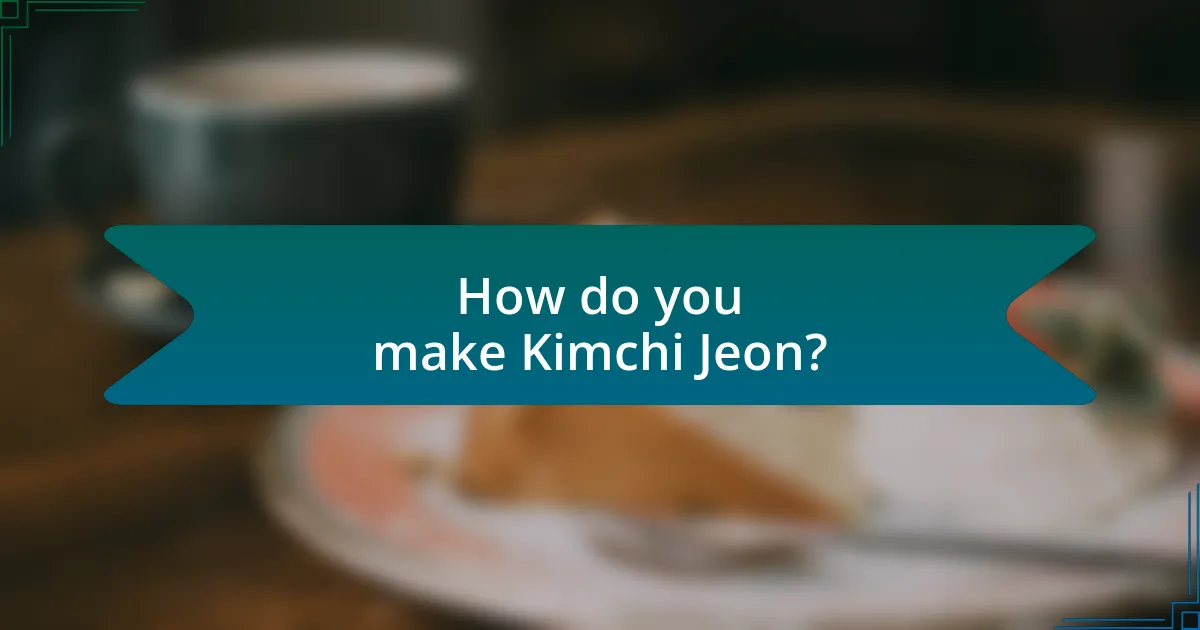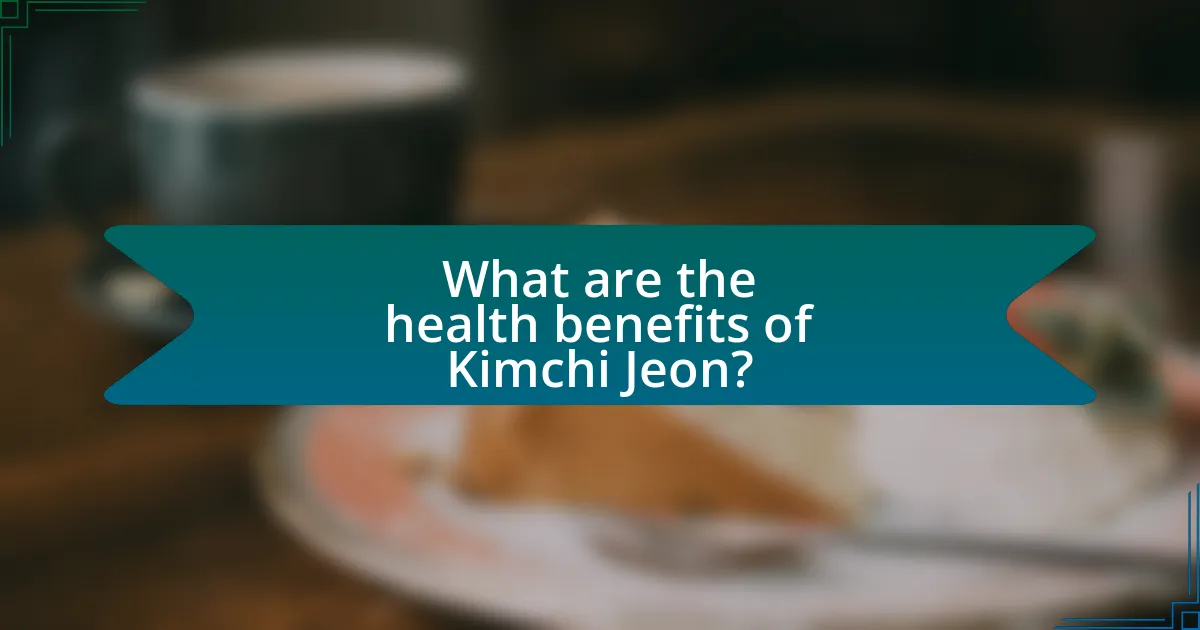Kimchi Jeon is a traditional Korean savory pancake made primarily from kimchi, flour, and water, known for its unique tangy flavor and crispy texture. This dish stands out from other pancakes due to its incorporation of fermented kimchi, which not only enhances its taste but also adds nutritional benefits. Essential ingredients include various types of kimchi, flour, water, and green onions, allowing for diverse flavor experiences. The article explores the cultural significance of Kimchi Jeon, its evolution over time, and provides detailed instructions on preparation, cooking techniques, and variations, highlighting its health benefits and tips for achieving the perfect texture.

What is Kimchi Jeon?
Kimchi Jeon is a Korean savory pancake made primarily from kimchi, flour, and water. This dish combines the fermented flavors of kimchi with a crispy texture, often enhanced by additional ingredients like scallions or seafood. Kimchi Jeon is traditionally served as a side dish or snack and is popular for its unique taste and ease of preparation.
How is Kimchi Jeon different from other pancakes?
Kimchi Jeon is distinct from other pancakes primarily due to its key ingredient, fermented kimchi, which imparts a unique tangy flavor and spicy kick. Unlike traditional pancakes that typically use simple batter made from flour, eggs, and milk, Kimchi Jeon incorporates chopped kimchi into the batter, enhancing its taste profile and texture. This savory pancake is also often pan-fried until crispy, creating a contrast between the crunchy exterior and the soft interior filled with kimchi. The use of kimchi not only differentiates its flavor but also adds nutritional benefits, as kimchi is rich in probiotics and vitamins.
What ingredients are essential for making Kimchi Jeon?
The essential ingredients for making Kimchi Jeon include kimchi, flour, water, and green onions. Kimchi provides the primary flavor and texture, while flour and water create the batter that holds the pancake together. Green onions add freshness and enhance the overall taste of the dish. These ingredients are fundamental to achieving the characteristic savory and slightly spicy profile of Kimchi Jeon.
What types of kimchi can be used in Kimchi Jeon?
Various types of kimchi can be used in Kimchi Jeon, including napa cabbage kimchi, radish kimchi, and green onion kimchi. Napa cabbage kimchi is the most common choice due to its flavor and texture, which complement the pancake’s batter. Radish kimchi adds a crunchy texture and a slightly different taste profile, while green onion kimchi contributes a fresh and aromatic element. These variations allow for diverse flavor experiences in Kimchi Jeon, making it a versatile dish.
Why is Kimchi Jeon popular in Korean cuisine?
Kimchi Jeon is popular in Korean cuisine due to its unique flavor profile and versatility as a dish. This savory pancake incorporates fermented kimchi, which adds a tangy and spicy taste, making it a beloved comfort food. Additionally, Kimchi Jeon can be enjoyed as a snack, appetizer, or main dish, appealing to various dining occasions. Its popularity is further supported by the cultural significance of kimchi in Korea, where it is a staple ingredient, reflecting the country’s culinary heritage.
What cultural significance does Kimchi Jeon hold?
Kimchi Jeon holds significant cultural importance in Korean cuisine as a traditional dish that embodies the values of resourcefulness and communal eating. This savory pancake is often made with leftover kimchi, reflecting the Korean practice of minimizing food waste and maximizing flavor. Historically, Kimchi Jeon has been enjoyed during family gatherings and celebrations, symbolizing togetherness and shared heritage. Its preparation and consumption foster social bonds, making it a staple in both everyday meals and special occasions in Korean culture.
How has Kimchi Jeon evolved over time?
Kimchi Jeon has evolved from a traditional Korean dish primarily made with leftover kimchi and flour into a versatile savory pancake enjoyed in various forms worldwide. Historically, Kimchi Jeon was created as a way to utilize overripe kimchi, reflecting the resourcefulness of Korean cuisine. Over time, the dish has incorporated diverse ingredients such as seafood, vegetables, and different types of flour, adapting to regional tastes and dietary preferences. This evolution is evidenced by its presence in modern fusion cuisine, where chefs experiment with flavors and textures, showcasing Kimchi Jeon in gourmet settings and international menus.

How do you make Kimchi Jeon?
To make Kimchi Jeon, combine chopped kimchi, flour, and water to create a batter. The typical ratio is one cup of flour to half a cup of water, mixed with one cup of chopped kimchi. Heat a non-stick skillet with oil over medium heat, pour in the batter, and cook until both sides are golden brown, usually about 3-4 minutes per side. This method is validated by traditional Korean recipes that emphasize the balance of ingredients for optimal flavor and texture.
What are the steps involved in preparing Kimchi Jeon?
To prepare Kimchi Jeon, follow these steps: First, gather ingredients including chopped kimchi, flour, water, and optional vegetables or proteins. Next, mix the chopped kimchi with flour and water to create a batter, ensuring the consistency is thick enough to hold together. Then, heat oil in a pan over medium heat and pour in the batter, spreading it evenly. Cook until the edges are crispy and the bottom is golden brown, then flip to cook the other side. Finally, serve the Kimchi Jeon hot, often accompanied by a dipping sauce. These steps ensure a delicious and authentic savory pancake.
How do you prepare the batter for Kimchi Jeon?
To prepare the batter for Kimchi Jeon, combine all-purpose flour, water, and chopped kimchi in a mixing bowl. The typical ratio is one cup of flour to one cup of water, adjusted for desired thickness, and about half a cup of chopped kimchi is added for flavor. This mixture should be stirred until smooth, ensuring there are no lumps, which is essential for achieving the right texture in the pancake.
What cooking techniques are best for achieving the perfect texture?
The best cooking techniques for achieving the perfect texture in Kimchi Jeon include pan-frying and steaming. Pan-frying allows for a crispy exterior while maintaining a tender interior, which is essential for the desired texture of the pancake. Steaming can also be used to ensure that the ingredients are cooked evenly and retain moisture, contributing to a soft and fluffy texture. These techniques are validated by traditional Korean cooking methods, which emphasize the balance between crispiness and softness in savory pancakes.
What variations of Kimchi Jeon exist?
Variations of Kimchi Jeon include classic Kimchi Jeon, which features fermented napa cabbage kimchi, and seafood Kimchi Jeon, incorporating ingredients like shrimp or squid. Other variations consist of vegetable Kimchi Jeon, which adds various vegetables such as zucchini or green onions, and cheese Kimchi Jeon, where cheese is melted into the batter for a richer flavor. Each variation maintains the core element of kimchi but introduces different ingredients to enhance taste and texture.
How can you customize Kimchi Jeon with different ingredients?
You can customize Kimchi Jeon by incorporating various ingredients such as seafood, vegetables, or different types of flour. For instance, adding shrimp or squid enhances the flavor profile, while incorporating scallions or zucchini can add texture and nutrition. Additionally, using rice flour instead of all-purpose flour can create a gluten-free version of the pancake. These variations allow for a personalized taste experience while maintaining the essential characteristics of Kimchi Jeon.
What are some popular regional variations of Kimchi Jeon?
Popular regional variations of Kimchi Jeon include Pajeon from the Jeolla Province, which incorporates green onions, and Dongnae Jeon from Busan, known for its use of seafood. Additionally, the Gyeongsang Province features a variation that often includes various vegetables and meats, enhancing the flavor profile. Each of these regional adaptations reflects local ingredients and culinary traditions, showcasing the versatility of Kimchi Jeon across South Korea.

What are the health benefits of Kimchi Jeon?
Kimchi Jeon offers several health benefits, primarily due to its ingredients, which include kimchi and batter made from flour and water. The fermentation process of kimchi provides probiotics that support gut health, enhance digestion, and boost the immune system. Additionally, kimchi is rich in vitamins A, B, and C, as well as antioxidants, which can help reduce inflammation and improve overall health. The inclusion of vegetables in Kimchi Jeon contributes dietary fiber, promoting satiety and aiding in weight management. Studies have shown that fermented foods like kimchi can also have positive effects on mental health by potentially reducing symptoms of anxiety and depression.
How does Kimchi contribute to the nutritional value of Kimchi Jeon?
Kimchi enhances the nutritional value of Kimchi Jeon by providing essential vitamins, minerals, and probiotics. Specifically, kimchi is rich in vitamins A, B, and C, which support immune function and skin health. Additionally, the fermentation process of kimchi introduces beneficial probiotics that promote gut health and improve digestion. Studies have shown that fermented foods like kimchi can increase the bioavailability of nutrients, making them more accessible to the body. Thus, the inclusion of kimchi in Kimchi Jeon not only adds flavor but significantly boosts its overall nutritional profile.
What vitamins and minerals are found in Kimchi Jeon?
Kimchi Jeon contains several vitamins and minerals, including vitamin A, vitamin C, calcium, and iron. The fermentation process of kimchi enhances its nutritional profile, providing beneficial compounds such as probiotics, which support gut health. Additionally, the vegetables used in Kimchi Jeon, such as napa cabbage and scallions, contribute to its vitamin and mineral content, making it a nutritious option.
How can Kimchi Jeon fit into a balanced diet?
Kimchi Jeon can fit into a balanced diet by providing a source of vegetables, probiotics, and protein. The primary ingredient, kimchi, is rich in vitamins A, B, and C, as well as beneficial probiotics that support gut health. The pancake is typically made with flour and eggs, contributing carbohydrates and protein, which are essential for energy and muscle repair. Additionally, incorporating Kimchi Jeon into meals can enhance flavor without excessive calories, making it a nutritious option that aligns with dietary guidelines emphasizing the consumption of vegetables and fermented foods for overall health.
What are some tips for making the best Kimchi Jeon?
To make the best Kimchi Jeon, use well-fermented kimchi for a robust flavor and ensure the batter has the right consistency, combining flour and water in a 1:1 ratio. The fermentation process of kimchi enhances its taste, making it ideal for pancakes. Additionally, cook the pancakes in a hot pan with sufficient oil to achieve a crispy texture. The oil helps to create a golden-brown crust, which is essential for the perfect Kimchi Jeon. Finally, serve the pancakes immediately after cooking to maintain their crispiness, as they tend to soften when left to sit.
How can you ensure your Kimchi Jeon is crispy and flavorful?
To ensure your Kimchi Jeon is crispy and flavorful, use a high ratio of kimchi to batter and incorporate cornstarch into the batter. A higher proportion of kimchi enhances the flavor, while cornstarch contributes to a crispier texture by reducing moisture in the batter. Additionally, frying the pancakes in hot oil allows for immediate crisping, creating a golden-brown exterior. This method is supported by culinary techniques that emphasize the importance of moisture control and temperature in achieving desired textures in fried foods.
What common mistakes should you avoid when making Kimchi Jeon?
Common mistakes to avoid when making Kimchi Jeon include using overly watery batter, which can lead to a soggy texture. Ensuring the batter is thick enough allows for a crispy pancake. Another mistake is not using well-fermented kimchi; fresh kimchi lacks the depth of flavor that aged kimchi provides, which is essential for a rich taste. Additionally, cooking at too high a temperature can burn the outside while leaving the inside undercooked; a medium heat allows for even cooking. Lastly, overcrowding the pan can result in steaming rather than frying, so it’s best to cook in batches for optimal crispiness.


